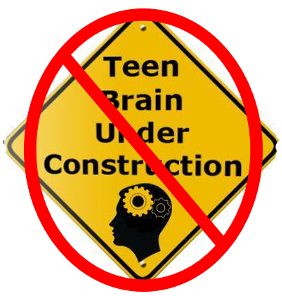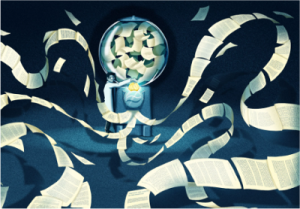Still Believe in the ‘Undeveloped Teen Brain?’ Well, don’t.
By Anthony Bernier | June 2023
The theory of the “teenage brain” purports to explain young peoples’ “impulsivity,” “volatile” emotions, and “risk-taking” behaviors. It’s a notion emerging from the 19th century’s concept of “Youth Development” and more recently advanced by some in the neuro-science field based  upon interpretations about the human brain’s prefrontal cortex, amygdala, hypothalamus, and how their “plasticity” renders them more immediately influenced by experience.
upon interpretations about the human brain’s prefrontal cortex, amygdala, hypothalamus, and how their “plasticity” renders them more immediately influenced by experience.
But a theory must account for facts.
Real theories emerge from rigorous examination over long periods of time under varied and different circumstances. Theories are refined over time to include new data, new interpretations, and undergo strenuous peer-review. More authoritative theory undergoes further testing through reproducing the same or similar results in subsequent trials. Ultimately, a theory should reliably explain and predict outcomes.
The “teen brain” theory can claim few of these.
Nevertheless, the “teen brain” theory has been adopted and promoted by many professional and interest groups claiming specialized knowledge, skills, and abilities in working with young people. Modern education uses it to segregate youth into finely sliced “grade levels” on the assumption that brains of a certain chronological age, not capacity, can handle only certain content. Psychologists and social workers use it to specialize by segregating young people from children and adult clients. The justice system uses it both to justify the “juvenile justice” system and to segregate (i.e. “protect”) youth in separate specialized institutions. Mercenary popular non-fiction authors made it a cottage industry. Even librarians use it to rationalize (i.e., “defend”) behaviors the institution otherwise feels “unacceptable.”
The teen brain theory is commonly deployed to “explain” youth behaviors that adults define as anti-social. It is often used as a defense against otherwise prevailing adultist assumptions: all teens are potentially dangerous and emotionally explosive, especially if they are not receiving careful and professional oversight and supervision. It appears in phrases like, “Oh, they can’t help it, their brains are just not developed.”
Politically, the teen brain theory is used on both the left and the right. For political conservatives, the concept is used to promote harsh anti-youth punishment regimes: curfews, “gang injunctions,” and so-called “zero tolerance” policy. Liberals likewise do not question the assumptions at the base of teen brain theory, but instead of punishment, prescribe a wide array of professional interventions, such as programs “to keep kids off the street.”
Both interpretations assume the inherent flawed and “underdeveloped” nature of youth. Both defer achieving “full development” to some far-off future and magical moment when “maturity” suddenly appears. And aspiring only to that magical future “mature” moment, teen brain theory also implicitly dismisses youth experience in the here and now.
While there are many ways the teen brain theory is susceptible to critical thought, exploring just  a few should lead at least to skepticism of what it advances if they do not discredit it entirely. Most recently, the highly respected magazine Science (published by the American Association for the Advancement of Science), reported that up to a third of some 5000 peer-reviewed neuroscience papers published in 2020 were likely plagiarized or entirely invented from whole cloth.[1] And beyond exposing these stunning fabrications of clinical science, which should alone render confidence in teen brain theory problematic, additional questions make it worse.
a few should lead at least to skepticism of what it advances if they do not discredit it entirely. Most recently, the highly respected magazine Science (published by the American Association for the Advancement of Science), reported that up to a third of some 5000 peer-reviewed neuroscience papers published in 2020 were likely plagiarized or entirely invented from whole cloth.[1] And beyond exposing these stunning fabrications of clinical science, which should alone render confidence in teen brain theory problematic, additional questions make it worse.
First and foremost, most teen brain research is conducted on a very thin demographic slice of the youth population (mostly middle-class white youth from wealthy countries). This fact alone should make us stomp hard on the brake pedal in indulging sweeping generalizations about all youth – particularly when considering working class youth or youth of color – both of whom are routinely singled out as “behavior problems.”
What possible single generalization can explain an entire demographic – to say nothing of predicting behavior as real theory does? What possible generalization could, for instance, explain all women or all people from a particular faith tradition?
As an historian, I am also compelled to acknowledge that teen brain theory purports universal application. Really? All youth, in all cultures, in all places, for all gender identities, for all time, exhibit the same “lacking” brain development manifested in the same ways?
Moreover, the “measuring stick” or criteria for characterizing youth as “un-developed” is the equally fictitious notion of the “mature adult.”
Now there is a notion worth scientific study!
[1] Brainard, J. (9 May 2023). Fake scientific papers are alarmingly common: But new tools show promise in tackling growing symptom of academia’s ‘publish or perish’ culture. Science 380, no. 6645, [https://www.science.org/content/article/fake-scientific-papers-are-alarmingly-common]
